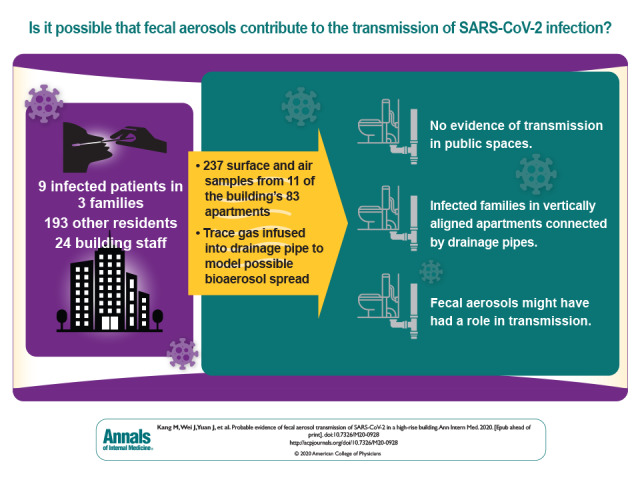- Record: found
- Abstract: found
- Article: not found
Probable Evidence of Fecal Aerosol Transmission of SARS-CoV-2 in a High-Rise Building

Abstract
The presence of severe acute respiratory syndrome coronavirus 2 (SARS-CoV-2) in fecal material has raised the possibility of viral transmission via a fecal–oral route. This study investigated whether SARS-CoV-2 transmission via fecal aerosols in the drainage pipe system may have been the cause of COVID-19 infection in a cluster of 3 families living in a high-rise building in China.
Abstract

The presence of severe acute respiratory syndrome coronavirus 2 (SARS-CoV-2) in fecal material has raised the possibility of viral transmission via a fecal–oral route. This study investigated whether SARS-CoV-2 transmission via fecal aerosols in the drainage pipe system may have been the cause of COVID-19 infection in a cluster of 3 families living in a high-rise building in China.
Abstract
Background:
The role of fecal aerosols in the transmission of severe acute respiratory syndrome coronavirus 2 has been suspected.
Objective:
To investigate the temporal and spatial distributions of 3 infected families in a high-rise apartment building and examine the associated environment variables to verify the role of fecal aerosols.
Design:
Epidemiologic survey and quantitative reverse transcriptase polymerase chain reaction analyses on throat swabs from the participants; 237 surface and air samples from 11 of the 83 flats in the building, public areas, and building drainage systems; and tracer gas released into bathrooms as a surrogate for virus-laden aerosols in the drainage system.
Participants:
9 infected patients, 193 other residents of the building, and 24 members of the building's management staff.
Measurements:
Locations of infected flats and positive environmental samples, and spread of virus-laden aerosols.
Results:
9 infected patients in 3 families were identified. The first family had a history of travel to the coronavirus disease 2019 (COVID-19) epicenter Wuhan, whereas the other 2 families had no travel history and a later onset of symptoms. No evidence was found for transmission via the elevator or elsewhere. The families lived in 3 vertically aligned flats connected by drainage pipes in the master bathrooms. Both the observed infections and the locations of positive environmental samples are consistent with the vertical spread of virus-laden aerosols via these stacks and vents.
Limitation:
Inability to determine whether the water seals were dried out in the flats of the infected families.